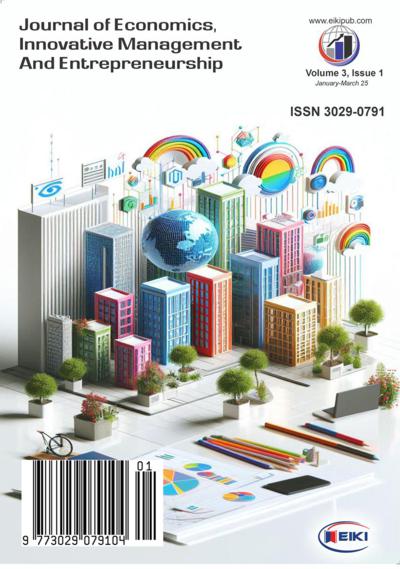Machine Learning-Driven Export Forecasting: A Comparative Analysis for MSME Growth
Main Article Content
Abstract
Micro, small, and medium enterprises play a fundamental role in economic devel-opment by fostering employment, innovation, and international trade. However, these enterprises face substantial challenges in volatile global trade conditions, necessitating accurate forecasting methodologies for effective strategic planning. This study aims to evaluate and compare traditional time series models and advanced machine learning techniques in predicting export trends. The research employs Double Exponential Smoothing and Autoregressive Integrated Moving Average alongside Support Vector Regression, Random Forest, and Extreme Gradient Boosting to assess forecasting accuracy. Performance metrics including Root Mean Square Error, Mean Square Error, Mean Absolute Error, Mean Absolute Percentage Error, and R-Square are utilized for model evaluation. Results indicate that while traditional time series models provide foundational forecasting insights, they are outperformed by machine learning techniques. Among these, Random Forest demonstrates the highest predictive accuracy and reliability. However, Extreme Gradient Boosting exhibits near-perfect met-rics, necessitating further scrutiny to address potential overfitting. The study empha-sises the necessity of integrating traditional and machine learning methodologies to enhance forecasting precision. These insights are valuable for policymakers, re-searchers, and industry practitioners seeking to strengthen export strategies and sus-tain economic growth.
Article Details

This work is licensed under a Creative Commons Attribution 4.0 International License.
References
Ahmed, N. K., Atiya, A. F., Gayar, N. El, & El-Shishiny, H. (2010). An Empirical Comparison of Machine Learning Models for Time Series Forecasting. Econometric Reviews, 29(5–6), 594–621. https://doi.org/10.1080/07474938.2010.481556
Bengio, Y. (2012). Practical Recommendations for Gradient-Based Training of Deep Architectures. In G. Montavon, G. B. Orr, K. R. Müller (eds) Neural Networks: Tricks of the Trade. Lecture Notes in Computer Science, vol 7700. Springer, Berlin, Heidelberg. https://doi.org/10.1007/978-3-642-35289-8_26
Breiman, L. (2001). Random Forests. Machine Learning, 45, 5-32. https://doi.org/10.1023/A:1010933404324
Chen, K.-Y., & Wang, C.-H. (2007). Support vector regression with genetic algorithms in forecasting tourism demand. Tourism Management, 28(1), 215-226. https://doi.org/10.1016/j.tourman.2005.12.018
Chen, T., & Guestrin, C. (2016). XGBoost: A scalable tree boosting system. Proceedings of the ACM SIGKDD International Conference on Knowledge Discovery and Data Mining (pp. 785–794). https://doi.org/10.1145/2939672.2939785
Dave, E., Leonardo, A., Jeanice, M., & Hanafiah, N. (2021). Forecasting Indonesia Exports using a Hybrid Model ARIMA-LSTM. Procedia Computer Science, 179, 480–487. https://doi.org/10.1016/j.procs.2021.01.031
De Gooijer, J. G., & Hyndman, R. J. (2005). 25 Years of Iif Time Series Forecasting: A Selective Review. Tinbergen Institute Discussion Papers No. TI 05-068/4. http://dx.doi.org/10.2139/ssrn.748904
Gkypali, A., Love, J. H., & Roper, S. (2021). Export status and SME productivity: Learning-to-export versus learn-ing-by-exporting. Journal of Business Research, 128, 486-498. https://doi.org/10.1016/j.jbusres.2021.02.026
Hastie, T., Tibshirani, R., & Friedman, J. (2017). The Elements of Statistical Learning: Data Mining, Inference, and Prediction, 2nd Edition. Springer.
Hiremath, G. S., & Deb, S. (2022). Export Performance of MSMEs in India: Is Credit Constraint an Invisible Gorilla? The Indian Economic Journal, 70(1), 138-157. https://doi.org/10.1177/00194662211062417
Hyndman, R. J., & Athanasopoulos, G. (2018). Forecasting: Principles and Practice. OTexts
Iaousse, M., Jouilil, Y., Bouincha, M., & Mentagui, D. (2023). A Comparative Simulation Study of Classical and Machine Learning Techniques for Forecasting Time Series Data. International Journal of Online and Biomedical Engineering, 19(8), 56–65. https://doi.org/10.3991/ijoe.v19i08.39853
Ji, L., Zou, Y., He, K., & Zhu, B. (2019). Carbon futures price forecasting based with ARIMA-CNN-LSTM model. Procedia Computer Science, 162, 33–38. https://doi.org/10.1016/j.procs.2019.11.254
Karthika, S., Margaret, V., & Balaraman, K. (2017). Hybrid short term load forecasting using ARIMA-SVM. In 2017 Innovations in Power and Advanced Computing Technologies (i-PACT) (pp. 1-7). https://doi.org/10.1109/IPACT.2017.8245060
Makridakis, S., & Hibon, M. (2000). The M3-Competition: results, conclusions and implications. International Journal of Forecasting, 16(4), 451-476. https://doi.org/10.1016/S0169-2070(00)00057-1
Motahar Hossain, M., & Pathak, N. (2023). Modeling the Impact of Access to Finance on MSMEs’ Contribution Towards Exports of the Economy. In J. Choudrie, P. N. Mahalle, T. Perumal, A. Joshi, A. (eds) ICT with Intelligent Applications. ICTIS 2023. Lecture Notes in Networks and Systems, vol 719. Springer, Singapore. https://doi.org/10.1007/978-981-99-3758-5_14
Noor Salim, M., Susilastuti, D., & Astuty, P. (2021). Economics and Business Quarterly Reviews Determinants of Indonesian MSME Exports and Their Performance during the Covid-19 Pandemic. Economics and Business Quarterly Reviews, 4, 162–173. https://doi.org/10.31014/aior.1992.04.03.379
Nursini, N. (2020). Micro, small, and medium enterprises (MSMEs) and poverty reduction: empirical evidence from Indonesia. Development Studies Research, 7(1), 153–166. https://doi.org/10.1080/21665095.2020.1823238
Rajput, N., Rajput, A., Batra, G., & Oberoi, S. (2012). Relationship of exports, Forex and MSMEs in India: an econometric study. Problems and Perspectives in Management, 10(3). https://www.businessperspectives.org/index.php/journals/problems-and-perspectives-in-management/issue-37/relationship-of-exports-forex-and-msmes-in-india-an-econometric-study
Ray, S., Lama, A., Mishra, P., Biswas, T., Sankar Das, S., & Gurung, B. (2023). An ARIMA-LSTM model for predicting volatile agricultural price series with random forest technique. Applied Soft Computing, 149(A), 110939. https://doi.org/10.1016/j.asoc.2023.110939.
Tay, F. E. H., & Cao, L. (2001). Application of support vector machines in nancial time series forecasting. Omega, 29(4), 309-314. https://doi.org/10.1016/S0305-0483(01)00026-3

